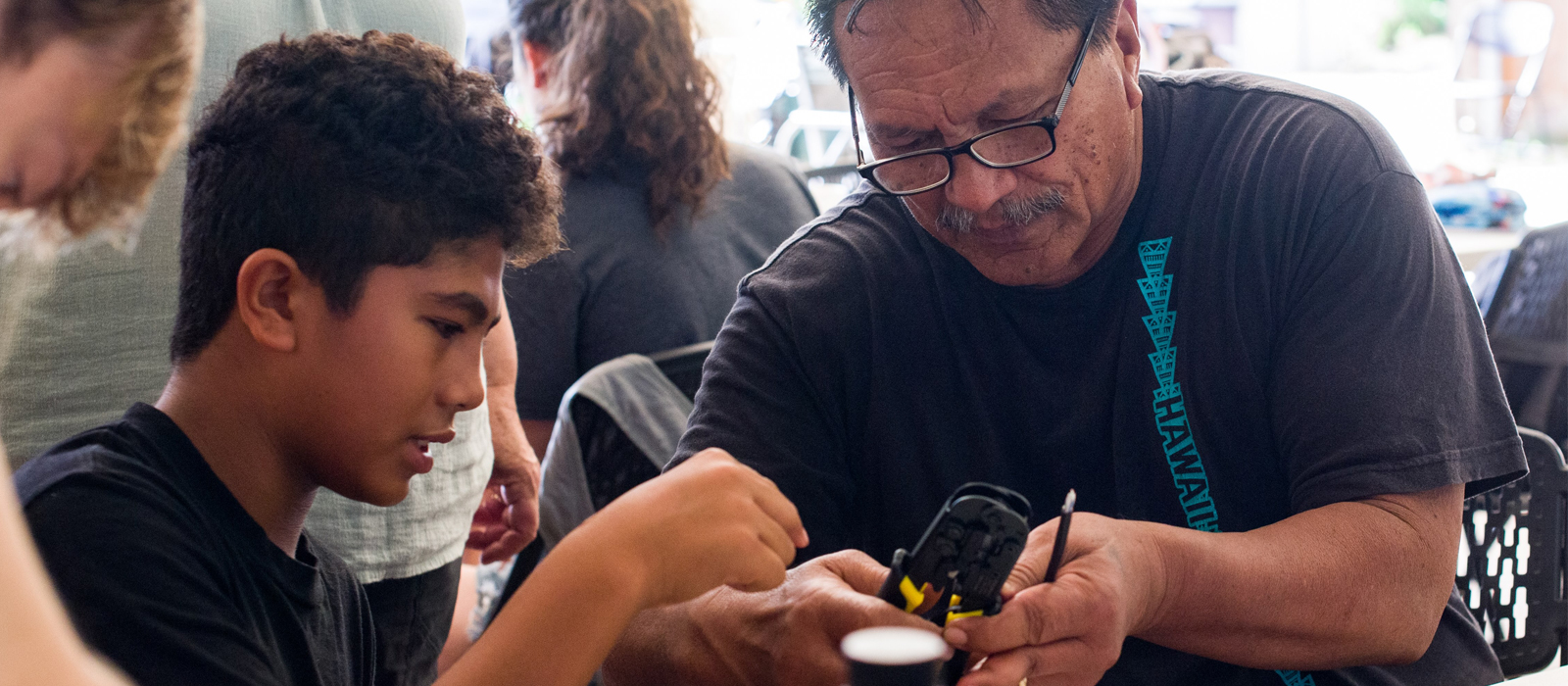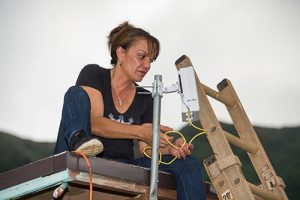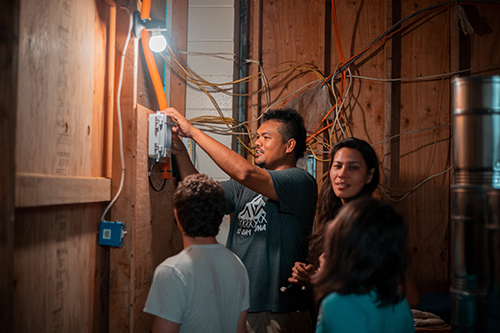
Dennis “Bumpy” Kanahele and his grandson Paiea Oleole-Kanahele participate in community network training hosted by the Internet Society in Pu‘uhonua o Waimānalo
Photographer: Christopher Mitchell, Director, Community Broadband Networks, Institute for Local Self-Reliance
The islands of Hawaiʻi have always served as vibrant communication hubs – long before European settlers arrived, Kānaka Maoli (Indigenous people of Hawai‘i) exchanged information and connected over distances. King Kalākaua had telephones installed in ʻIolani Palace several years before the White House. Today, these activities continue as communities are deploying telecommunications as a component of nation-building, and to address access and affordability divides that persist in the islands (Winter, Buente & Buskirk, 2014). In a recent statewide survey conducted by Kamehameha Schools and Marzano Research, 34% of Native Hawaiians and 35% of non-Hawaiians reported insufficient access to digital devices and Internet connectivity (‘Imi Pono Hawai‘i Well-Being Survey, 2021). This reflects deeper digital inequalities than previously indicated in sources like 2019 American Community Survey data that found only 12% of Hawaiʻi households lack Internet access. For those households struggling economically, almost one in three have no Internet service.
COVID-19 made these differences even more significant yet also catalyzed a nascent community networking movement. Unlike prior top-down initiatives, this movement is bottom-up and community-driven, recalling early digital networking as well as calls for Indigenous self-determination in the information age issued in Hawaiʻi as early as 1995 (Crawford & Bray-Crawford, 1995). In the same spirit as their work building housing, water, and electrical infrastructures on their territories, Native Hawaiians are establishing their own Internet systems – and in doing so, sharing important lessons about appropriate and inclusive forms of technology development.
 Holly Billups-Pagan helps install a wireless network antenna on a house in Pu‘uhonua o Waimānalo.
Holly Billups-Pagan helps install a wireless network antenna on a house in Pu‘uhonua o Waimānalo.
Photographer: Christopher Mitchell, Director, Community Broadband Networks, Institute for Local Self-Reliance
Pu‘uhonua o Waimānalo, a community of 90 people on Oʻahu, demonstrates how digital connectivity intersects with nation-building (Maka‘awa‘awa, 2020). The current location of the Nation of Hawai‘i emerged from political events that demonstrated the historical basis for Hawaiian claims for sovereignty (Goodyear-Ka‘ōpua, 2014). On 17 January 1993, an estimated 20,000 Kānaka Maoli and supporters converged on ‘Iolani Palace, and during the Peoples’ International Tribunal, Ka Ho‘okolokolonui Kānaka Maoli, the United States was found guilty for its armed invasion of Hawai‘i in 1893 by a tribunal of international human rights experts and advocates (Blaisdell, Minton & Hasager, 2014). Hawaiian independence leader Puʻuhonua “Bumpy” Kanahele organized a 15-month occupation of Kaupō Beach in Waimānalo that “not only emphasized the historical and legal bases for an independent Hawaiian nation, but also underscored the real, material needs of Kānaka Maoli for homes and for ʻāina” (Goodyear-Ka‘ōpua, 2014, p. 18). In June 1994, Kanahele formed the Nation of Hawai‘i on state-owned mauka lands – an exemplar of nation-building relying on a foundation of legal frameworks and international relations to restore, maintain, and preserve the sophisticated religion, language, and culture of Native Hawaiian people (Nation of Hawai‘i, 2019).
This work continues in the context of digital connectivity. In November 2019, Pu‘uhonua o Waimānalo participated in a community network training and deployment initiative funded and organized by the Internet Society, as part of the third annual Indigenous Connectivity Summit. A series of pre-conference training webinars was followed by two days of hands-on technical training and the launch of a fixed wireless network that redistributes high-speed backhaul from Hawaiian Telcom to residents at a cost of USD 360 per month. The success of the Waimānalo network sparked a similar initiative on the west coast of Oʻahu, in the 250-person settlement of Pu‘uhonua o Waiʻanae. After participating in the Waimānalo build, James Pakele began working with Hawaiian Telcom and the Internet Society to deploy a fiber link along Waiʻanae Valley road to connect the 20 acres of land purchased by the community in 2018.
These two projects on Oʻahu are accompanied by network-building in Kīpahulu ‘Ohana, an off-grid grassroots nonprofit organization founded in 1995 in southeastern Maui. Along with providing community Internet access via a roadside farm stand/cafe, the organization is interested in exploring the use of digital applications to support its taro farming, shoreline management, and other food security projects. That project involves Scott Crawford, who lived in Pu‘uhonua o Waimānalo in the mid-1990s and is co-author of the 1995 paper on digital self-determination. A fourth project will connect farmers living and working on the west side of Molokaʻi.
 Brandon Makaʻawaʻawa, Mariel Triggs from MuralNET, Spencer Sevilla, and others work on installing the community networks in Pu‘uhonua o Waimānalo.
Brandon Makaʻawaʻawa, Mariel Triggs from MuralNET, Spencer Sevilla, and others work on installing the community networks in Pu‘uhonua o Waimānalo.
Photographer: John Kealoha Garcia, Nation of Hawaii
These Indigenous community networking initiatives are supported by funds raised by Lihla Noori at Kamehameha Schools and taking shape through relationships between community members, the State of Hawaiʻi, and Hawaiian Telcom – all members of the Broadband Hui founded by Burt Lum, broadband strategy officer at the State of Hawaiʻi. Along with access to funding, technical training and expertise, and backhaul services, the Hui’s advocacy efforts redefined eligibility criteria for the Federal Communications Commission’s 2.5 GHz Rural Tribal Window to include Hawaiian Homelands, which opens possibilities for fixed wireless networks. Its work is accompanied by efforts led by Brad Kaleo Bennett from the Kuauli Digital Opportunities Initiative to distribute 800 refurbished computers across the state, and to fill knowledge gaps in FCC broadband maps with on-the-ground data provided by local researchers. These and other activities are reflected in the Hui’s Digital Equity Declaration.
Along with sessions on emergent technologies, business models, and policy/regulatory developments, PTC’s research activities offer a forum for academic, community, government, and industry partners to learn about these and other initiatives.
Rob McMahon is associate professor of media and technology studies at the University of Alberta, Canada. He was the recipient of the 2020 Meheroo Jussawalla Research Award and PTC’21 Program Participant on a panel about community networks. Read more about his research on rural, northern and Indigenous technology development.
Wayne Buente is associate professor in the School of Communications at the University of Hawaiʻi at Mānoa. His research examines the interplay between society and information and communication technologies (ICTs). Research projects have examined issues relating to information systems, digital inequality, social media, and health disparities.
Brandon Maka‘awa‘awa is deputy head of state of the Nation of Hawaiʻi, the oldest Hawaiian independence organization in Hawaiʻi. He assists Head of State Dennis “Bumpy” Kanahele in the daily operations of the village of Pu‘uhonua o Waimānalo, the nation’s sovereign landbase. Brandon also helps to manage the Pu’uhonua O Waimānalo community broadband network.




